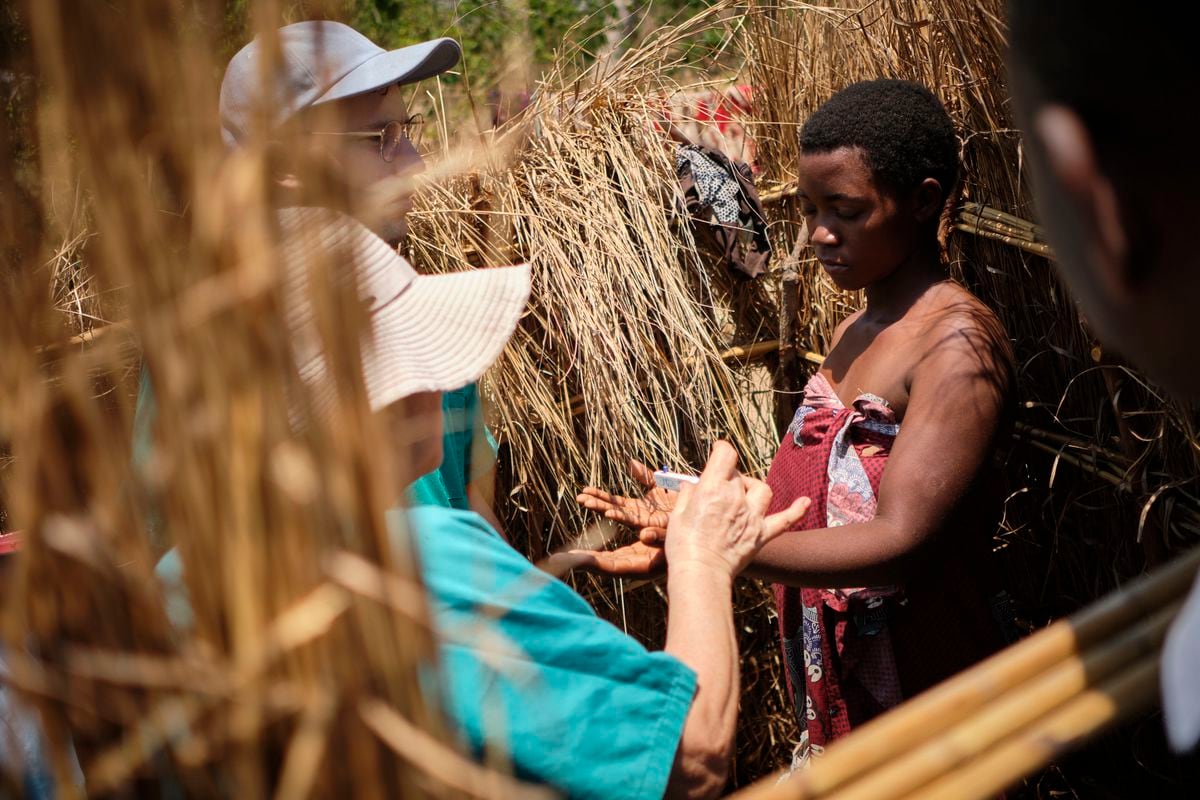Two years ago, AK, a 23-year-old Malawian woman, began to see a small white spot on her arm.
At first she was just that, a speck, and she didn't pay any more attention to it.
In Ngalauka, the community where she lives, A. she has many chores: she is the mother of a two-year-old child, a farmer, and she also has to help her parents because they are sick.
The little spot, little by little, grew larger until one day another appeared.
As with the first, A. continued with her life since neither one nor the other prevented him from raising her son, tilling her land or taking care of her parents.
What she did not know was that that little spot was the first symptom that indicated that she had contracted leprosy.
A.'s life would have continued the same if it weren't for the fact that one day some dermatologists appeared in his community.
They came to check on her parents, sick with leprosy, to check her condition.
In addition to following up on diagnosed patients and seeing how they progress with treatment, doctors in the Dermalawi project do contact tracing.
Leprosy, a neglected tropical disease, spreads very slowly (the incubation period is between 5 and 30 years) through the respiratory tract and prolonged direct contact between an untreated patient and a healthy person.
That is why it is important to check the rest of the family.
Seven people live in A.'s house and only two, her father and her mother, were diagnosed.
Now there are three.
If health personnel are not educated about this disease, the patient will go home without treatment, increasing the risk of infection, worsening and, ultimately, amputation
The WHO established the clinical diagnosis if at least one of these three signs occurs: definitive loss of sensation in a patch or spot on the skin;
thickened or enlarged peripheral nerve with loss of sensation and/or weakness of the muscles supplied by that nerve;
or presence of acid-fast bacilli (ie, the leprosy bacterium: Hansen's bacillus).
When Águeda Pulpillo and Víctor Dios, two dermatologists from the project, examined A., she presented a lack of sensitivity both in the spot and in her hands and feet.
Nothing else was needed to diagnose it: they gave her MDT (multidrug therapy), the drug indicated to treat the disease since, as Pulpillo explains, "not giving it to her today would be much worse than waiting for confirmation of the laboratory".
Despite the fact that leprosy was eradicated in Malawi in 1994 (the WHO considers that this disease is not a public health problem when there is less than 1 case per 10,000 inhabitants), the data collected by the Ministry of Health and Dermalawi show that contrary.
According to the figures of the National Program for the Elimination of Tuberculosis and Leprosy, there are currently 679 cases under treatment.
Only between July and September 2022, 141 were detected (in 2021, 235 throughout the year).
In 2022, Dermalawi detected 29 more, four of them thanks to the contact tracing program, which is the review of relatives and neighbors in the homes of diagnosed patients, and since 2018 they have already had more than 80 in the region where they work: the leprosy in Malawi is still very present.
Southeast Asia is by far the most leprosy-affected region in the world, with 93,485 cases.
The worst part is taken by India, which currently has 75,394 infected, which represents more than 53% of the cases worldwide.
The other most affected countries are Brazil, Indonesia, the Democratic Republic of the Congo and Mozambique.
With 21,201 cases, Africa is the second most affected region.
46 countries on the continent have eliminated leprosy as a public health problem (that is, less than 1 case per 10,000 inhabitants) and the number of new cases has fallen by 66% over the last 20 years, according to the WHO.
However, Yosei Sasakawa, WHO Goodwill Ambassador for the Elimination of Leprosy, explained in a statement in 2022 that “in many countries, measures against leprosy,
Since the year 2000, Novartis has donated through the WHO more than 68 million containers of MDT.
In 2021, he renewed his donation commitment until 2025, which meant that the treatment continues to be free throughout the world.
Still, eradicating leprosy is not that simple, as many other factors come into play.
In the case of Malawi, a country ranked 169 on the Human Development Index, they are the training of health personnel and access to health centers: "When a patient arrives at a local health center, two things happen: that the The medical team does not have the knowledge to detect it, so they are referred to the district hospital and, consequently, the patient must travel to that hospital to receive the diagnosis, which is something unaffordable both due to distance, lack of means of transportation and money,” explains Fátima Kalima, coordinator of the central and eastern Malawi area of the National Program for the Elimination of Tuberculosis and Leprosy, a program that operates under the umbrella of the Ministry of Health.
Fight leprosy with education
Dr. James Mpunga, director of the program, explains the first steps they are implementing: “In local health centers, we have begun to develop training so that health workers can recognize signs and symptoms, detection, diagnosis and treatment.
We are also supplying the establishments below the district level with medicines.
This has started in the health centers of the districts where the notification of cases is high”.
Two of the districts where more leprosy has been diagnosed are Nkhotakota and Salima, precisely where Dermalawi focuses her work.
Gisela Petiti, the project director, explains why the numbers are highest where they work: “In Nkhotakota and Salima, the largest number of patients have been identified due to the active search we do.
It may seem that this is where there is the most leprosy, but that is just a mirage that reflects the lack of detection in other places”.
Statistically there are more because there are more people diagnosing and doing contact tracing, which leads to the detection of new patients in the family and neighborhood nucleus.
According to Dr. Mpunga, there are many cases in the communities that have not yet been detected.
Leprosy is known as a disease of poverty and only in the poorest areas of the world is it still endemic.
During the week of October 24, the Ministry of Health organized in Dedza the first training session for health workers from five hospitals in the district: “The decentralization of disease control services and the training of medical assistants, nurses and officials is our primary objective,” explains Dr. Mpunga.
Another separate problem is resources.
Despite the fact that the Fontilles Foundation, a historic Spanish institution, collaborates with Dermalawi by carrying out the PCR analysis of doubtful leprosy patients, the diagnosis in this country is only clinical and there is no specialized laboratory.
In 2020, 127,558 new cases were detected worldwide, including 8,629 in children under 15 years of age, according to the WHO.
Ignorance, the greater evil
BJ is 17 years old and lives in Kalungama, one of those villages on both sides of an endless dirt road.
In April 2021 he was diagnosed with leprosy and in June he began his treatment.
He had to take it in a period between 12 and 18 months, but B. did not care, he was fickle and in a year and a half he had only taken eight containers.
The dermatologists arrived in Kalungama in October 2022 and found B. much worse than at the beginning: he was apathetic, depressed, with irreversible damage to the ocular and facial nerves and pain in his hands and feet: the so-called paresthesias.
Now B. must start the treatment again due to the worsening of the disease and because he discontinued the medication.
If health personnel are not educated about the disease, the patient will go home without treatment, increasing the risk of infection, worsening, and eventually amputation.
Avoiding this type of situation is the main task of Texon Phiri, a social worker from the Nkhotakota and Salima area.
The lack of mechanisms of the Ministry of Health has put it to work: Texon moves through the communities of the two most affected districts of the central region, making sure that no patient lacks treatment.
On his motorcycle, together with his team of volunteers, he travels through the communities to administer it and follow up on the sick.
This last activity has helped to sensitize cohabitants of leprosy patients so that they go to the district hospitals on their own.
Texon has been carrying out for years what the National Program for the Elimination of Tuberculosis and Leprosy is beginning to implement now.
Fatima Kalima, who is also an official in dermatology, says that the strategic plan of the Ministry of Health to combat leprosy is very good on paper, but its implementation fails: "There are many cases and we cannot trust the statistics because we do not they are reliable.
Right now we are not winning the battle,” she explains.
In Mpamantha, an isolated village reached by going down a rutted, dusty road, Thokozani Tambulasi, the medical assistant in charge of the health center reaffirms the ignorance of health personnel about this disease: “Sometimes patients come to us with injuries, but we are afraid of getting infected and many times we do not cure them”.
The risk of contagion by contact with a wound is simply nil.
These wounds, caused by trauma or burns,
They are due to the lack of sensitivity caused by the disease, which means that the person does not feel pain in their injuries and that they continue to worsen.
If healthcare personnel are not trained on Hansen's bacillus, the patient will go home without treatment, increasing the risk of infection, worsening, and eventually amputation.
leprosy and famine
Leprosy is known as a disease of poverty and only in the poorest areas of the world is it still endemic, many experts explain.
In Malawi, 85% of the population is dedicated to agriculture, and 70% does so on small and subsistence farms, according to the country file of the Office of Diplomatic Information of the Ministry of Foreign Affairs, European Union and Cooperation.
Peter W. is one of those farmers, but this year he was unable to pick up the hoe to sow his land because he has one of the most visible and disabling signs of the disease: claw hand, caused by thickening of the ulnar nerve. .
Peter had to pay other people to farm his land, an unaffordable expense for many…for most.
Despite the fact that the country's Ministry of Health has begun to move forward, everything related to leprosy in Malawi is still in its infancy.
The delay in the implementation of strategic measures has left many people at risk of contagion and the lack of training has prevented the detection of new cases, which is why official data is as certain as it is insufficient.
Despite this, the hope of achieving the goal 'Towards zero leprosy': zero infection and disease, zero disabilities, zero stigma and zero discrimination, is not lost.
You can follow PLANETA FUTURO on
,
and
, and subscribe
here
to our 'newsletter'
.









